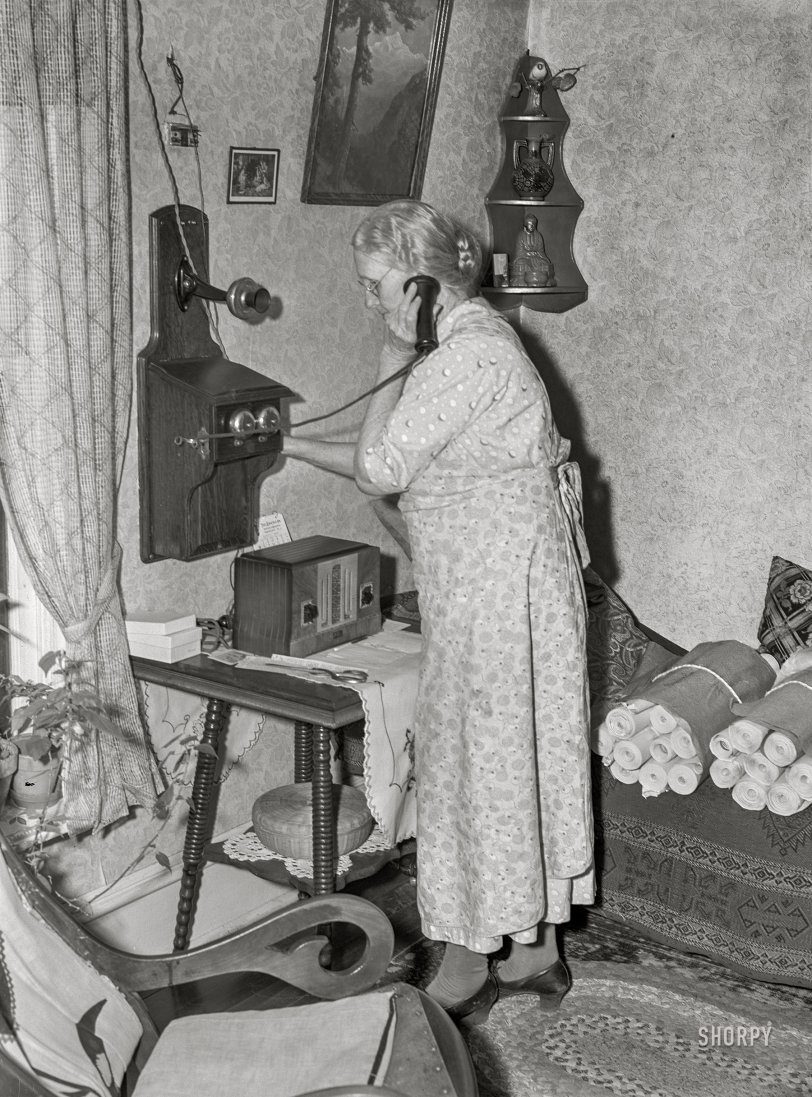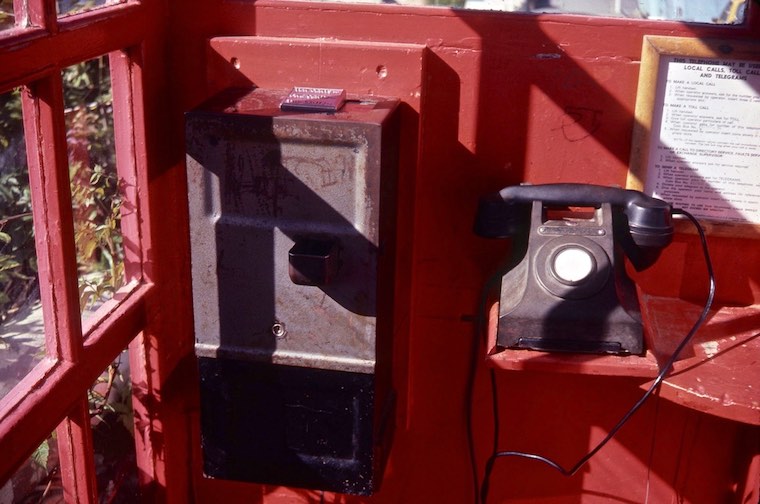


Framed or unframed, desk size to sofa size, printed by us in Arizona and Alabama since 2007. Explore now.
Shorpy is funded by you. Patreon contributors get an ad-free experience.
Learn more.

- Indiana Harbor Belt abides
- Freezing haze
- Corrections (for those who care)
- C&NW at Nelson
- Fallen Flags
- A dangerous job made worse
- Water Stop
- Passenger trains have right of way over freights?
- Coal
- Never ceases to amaze me.
- Still chuggin' (in model form)
- Great shot
- Westerly Breeze
- For the men, a trapeze
- Tickled
- Sense of loneliness ...
- 2 cents
- Charm City
- What an Outrage
- Brighton Park
- Catenary Supports
- Just a Little Before I was Born
- Afternoon normal
- The Flat Iron Cafe survives
- Aging in Place
- Raise your hand
- Good and Bad
- Oh, the 70's
- Nooooooi
- The aluminum tubing
Print Emporium
Crank Call: 1940

April 1940. "Lady signaling operator on old-style telephone. Scranton, Iowa." Medium format acetate negative by John Vachon for the Resettlement Administration. View full size.
Isn't It Obvious?
Those rolls next to her can't be anything but more wallpaper that needs hanging!
I really like the woodworking on that fern table in front of her!
Buddha
My grandmother had one -- an incense burner, in green-red-gold.
More!
A person can never have too much wallpaper. Well, maybe sometimes.
No hands voice dialing
That phone used no hands voice dialing, an amazing technology that is virtually unavailable today.
About those rolls
I'm probably wrong but, those rolls seem to me to be too narrow. Is it possible that they are player piano rolls? A couple of them seem to have narrow wooden slats along one edge. I remember seeing player pianos in one of my aunt's homes when I was a kid in the early 1950s and they generally looked like these, but were usually stored in boxes.
She doesn't look Buddhist
Seriously, I am a little surprised by the Buddha figure on her shelf. Grandma was practicing way before it was hip!
Oh, my aching back
I'm pretty sure her phone calls never lasted long - look at the posture she has to assume. That table makes her stand about two feet away from the phone and then lean forward over the table to get close to the mouth piece. I'm surprised I don't see a hand mark on the wallpaper from bracing oneself. And of course she'd never just clear that table and sit on top of it.
"Turn crank briskly ... "
In October of 1975 I drove my 1965 Falcon from Vancouver, Canada, to San Francisco on a leisurely trip down the coast. I arrived at a road junction north of Fort Bragg, and saw a phone booth. I planned to stay with friends in San Francisco, and thought this was a good time to call and let them know of my arrival day. Upon entering the booth, I discovered the pay phone had no dial, and below it was a black box with a crank on it. There were detailed hand-written instructions on how to use it.
"Remove handset to be sure line is clear." There was no dial tone, and this was to determine if anyone else was using the party line. "Replace receiver, and turn crank briskly to signal operator." A male voice answered in Fort Bragg, and placed the call to San Francisco. The final instruction: "Turn crank briskly to clear the line". I charged the call to my Vancouver number, and when the bill came it read: "Call from North Rockport Toll Station No. 1."
Vancouver was one of the last large cities to convert to dial phones, a 20 year process finally completed in 1960.
A visit to New Zealand in 1985 revealed that some small towns still had not received dial telephones, as shown in this photo of a pay phone in Taihape.

Makes me think of Bryant Pond, Maine
Bryant Pond was the last community in the U.S. to have crank telephones, switching over to plain vanilla dial phones in 1983.
To call my friend in Bryant Pond, I had to dial 0 and ask the operator (remember operators?) to place a call to Bryant Pond 32 -- which was my friend's number. Some operators took it in stride; others took some convincing.
Where's the bird?
She looks a lot like Granny from the Tweetie and Sylvester cartoon.
Calling up Catfish
My grandfather (b. 1898) had the innards of one of those telephones in a bucket in his fishing boat. When he was hungry for catfish, he'd load me up and we'd go out to a deep bend on the Clear Fork of the Brazos and slide the jonboat through the reeds and into the river a couple hundred feet upstream of the bend.
On one of the copper telephone wires he had tied a horseshoe as a weight, which he dropped straight down off the side of the boat. The other, much longer wire was tied to a big iron washer -- about the size of a #10 can lid. I'd paddle down to the deepest hole in the river and he would swing the washer over his head like a lasso and toss it as far as he could. As soon as the washer hit the water, he'd holler "crank it!" and I'd wind the magneto as fast as I could, creating a current between the two poles and stunning any catfish caught in between them. After a few seconds he'd get the dipnet and scoop up any electroshocked fish and we'd repeat until he had enough for a fish fry.
I later discovered this was regarded as unsporting and possibly illegal means of harvesting fishflesh. In the mid-'60s, however, I never passed up and opportunity to go "call up some catfish".
Corner shelf
I made one in wood shop class identical to that one in junior high school around 1977.
Roll Call
She has rolls of something in bundles and it seems she's calling the person she prepared them for to say they are ready. Perhaps she is making some side money. What are they?
Just When You Think
It could it get any better? Dave comes up with this caption!!! Now I have to add THIS ONE to my all time favourites list.
[Thank you! Although "Crank Call" is the title, not the caption. The caption is the writing under the photo. - Dave]
[Right! My old brain needs to reboot :) - Baxado ]
I have the wheat paste
but could you bring the brushes and seam roller when you come over to help hang the wallpaper today? I have to burn some incense in the Buddha to cover up the smell from Bob's fish dinner.
























On Shorpy:
Today’s Top 5